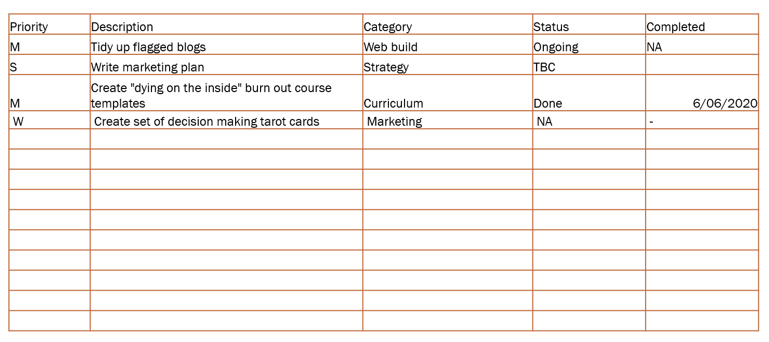Managing your freelance workload can be a challenge at times. Having too many things to do or too many opportunities can really start to become draining. And it can increase the chance of dropping the ball enormously. Not to mention increase the mental clutter.
Of all the ways to categorise what you need to attack a growing freelance workload, MSCW has to be my favourite.
MOSCOW (MSCW) stands for:
Must
Should
Could
Would but probably Won’t.
And it’s a simple way to look critically at what you need to go versus what is tickling the brain.
MSCW gives you order by creating priority. That order is determined by the things that matter to you in a project environment.
This usually means looking at it from the perspective of:
- The goals I want to achieve in a given period of time
- How mission critical the task is to that achievement
- The level of impact that task will have
- Whether I have the available resources to make it happen
How to use MSCW
- Put it all down – yep, all of that overwhelming shit
- Use ACTION words – write, decide, join etc
- Critically look at the list. Consider cross categorising it so you know what is what
- Assess on things like necessity, return on investment, ease of completion, resource drain, cost etc
- Rinse and repeat
What that means in real terms:
- What MUST you do to keep the project happening?
- What SHOULD you do to make it a complete project?
- What COULD you do to add additional value (but CAN’T see the value in moving this above other tasks)?
- What WOULD you do if you had time and resources (but likely WON’T get to)?
Here’s a sample of what I am taking about with freelance workload management with the Freelance Jungle Patreon in mind:

An Excel of tasks to complete given the priority Must, Should, Could, Would but probably Wont.
This can really help you get rid of that feeling of ideas forever competing with each other.
But what about the line items?
The beauty of the MSCW method is it can be adjusted to work with just about any aspect of your freelance workload. And your freelance marketing, products or even creative projects.
From here, break the individual projects and ideas down further into manageable chunks. For example, you might choose a big project that is to rewrite your entire website as a Must. But there are steps within that task that make the whole.
E.g.
- Selecting the SEO keywords
- Updating my bio
- Choosing which services I will offer in 2022
Give each separate line item with their own priority. That way, you won’t be overwhelmed by the sheer volume.
I have too many Musts!
Thinking all the things you need to do are dealbreakers is a big problem in freelancing.
Some items might seem important today, but in the reality of life, they may never be that necessary. And even if they are, it doesn’t mean they all have to be done at the same time.
I split my M’s and S’s again across days. How I determine what days to do something are:
- How they might connect with each other
- Short wins versus critical thinking
- Time permitting
- My energy levels and mood
- What will excite me to keep going (because M’s can sometimes be a little dry).
Using our website example again, you might be able to look at your web pages and see what you can get away with for the next three to six months compared to what needs immediate attention.
Choosing these items might include:
- What do you no longer offer that you need to remove as a reference?
- Adding additional relevant information to deter some kinds of clients and attract others
- Prioritising the landing page and/or the contact page due to high usage
- Taking items off the main menu so they aren’t highlighted but also to give you the time to figure out what to do about them
It’s all about ensuring you can work on what matters to you, your clients and the bottom line.
Want more ways to manage your freelance workload effectively? Check out the blog.

